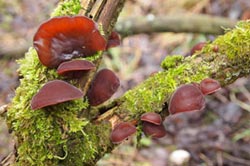Fungal Cleaning Crew

Specimens of the edible fungus Jew’s ear on a tree. / Source: René Ullrich/IHI Zittau<br>
Fungi serve as a kind of natural cleaning crew for the ecosystem. They form enzymes that can degrade hazardous substances, converting natural as well as man-made toxins into harmless compounds.
For instance, they can help to break down synthetic dyes, which accumulate in great amounts during the production of textiles. Prof. Dr. Dietmar A. Plattner, Dr. Klaus Piontek, and Eric Strittmatter from the Institute of Organic Chemistry of the University of Freiburg and their colleagues from research groups at the International Graduate School of Zittau of the University of Dresden have determined the three-dimensional atomic structure of an enzyme of this kind, a dye-decolorizing peroxidase (DyP). Their findings have now been published in the renowned Journal of Biological Chemistry (JBC).
In nature, all organisms make use of enzymes in order to build up and break down vital substances. These biocatalysts are often superior to traditional chemical processes as they enable chemical reactions under especially mild conditions. Several fungal enzymes are commonly used in industry as a replacement for other chemicals. In clothing production, for example, they are the reagents responsible for giving blue jeans a so-called stonewashed or used look.
Plattner’s research team is studying several fungal enzymes and attempting to analyze their structure. The scientists hope that this will lead to a better understanding of how the enzymes function. Up until the end of 2010, the scientists were consortium members of the European Union project BIORENEW that was funded with a total of 15 million. They are now participating in the project BioIndustrie2021, which is receiving 1.1 euros in funding from the Federal Ministry of Education and Research. The Freiburg researchers are currently focusing their efforts on enzymes of the class heme peroxidase. In the future, they hope to use their findings to design custom-made enzymes for industrial applications, making many chemical processes more environmentally friendly.
The dye-decolorizing peroxidase (DyP) belongs to the class of heme peroxidases and is isolated from Jew’s ear, an edible fungus indigenous to Germany. Piontek and Strittmatter used x-ray crystallographic methods to elucidate the atomic structure of the enzyme. With the help of this model, they determined how the substrate molecules need to bind to the enzyme in order to be converted to other substances in a chemical reaction. While studying this mechanism, they discovered an apparent contradiction: The binding pocket is only large enough for some of the substrate molecules – for the smaller chemical compounds that are converted by the enzyme. However, it is too small for larger and bulky substrates such as synthetic dyes. Hence, there must be another binding site on the surface of the enzyme that larger molecules can dock onto. The members of Plattner’s team succeeded in locating this site. In addition, they identified the amino acid that enables the enzyme to interact with the substrate and transfers an electron from the substrate molecule to the center of the enzyme. This is the second example of a so-called redox-active surface amino acid to be found in fungal enzymes to date.
Original publication: http://www.jbc.org/content/288/6/4095
Contact:
Prof. Dr. Dietmar A. Plattner
Institute of Organic Chemistry and Biochemistry
University of Freiburg
Phone: +49 (0)761 / 203-6013
E-Mail: Dietmar.Plattner@chemie.uni-freiburg.de
Dr. Klaus Piontek
Institute of Organic Chemistry and Biochemistry
University of Freiburg
Phone: +49 (0)761 / 203-6036
E-Mail: Klaus.Piontek@ocbc.uni-freiburg.de
Media Contact
All latest news from the category: Life Sciences and Chemistry
Articles and reports from the Life Sciences and chemistry area deal with applied and basic research into modern biology, chemistry and human medicine.
Valuable information can be found on a range of life sciences fields including bacteriology, biochemistry, bionics, bioinformatics, biophysics, biotechnology, genetics, geobotany, human biology, marine biology, microbiology, molecular biology, cellular biology, zoology, bioinorganic chemistry, microchemistry and environmental chemistry.
Newest articles

Properties of new materials for microchips
… can now be measured well. Reseachers of Delft University of Technology demonstrated measuring performance properties of ultrathin silicon membranes. Making ever smaller and more powerful chips requires new ultrathin…

Floating solar’s potential
… to support sustainable development by addressing climate, water, and energy goals holistically. A new study published this week in Nature Energy raises the potential for floating solar photovoltaics (FPV)…

Skyrmions move at record speeds
… a step towards the computing of the future. An international research team led by scientists from the CNRS1 has discovered that the magnetic nanobubbles2 known as skyrmions can be…





















